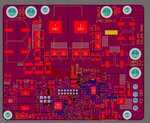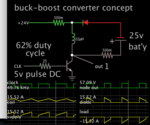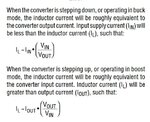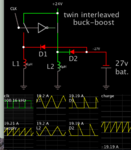ben5243
Member level 3

Hi all, I've read through the other LTC4020 threads on here but couldn't find my problem.
I've prototyped a LTC4020 buck boost charger for a Li-ion battery meant to charge 7-cell at 10A maximum.
Input Voltage: 19-29V (24V nominal)
V_float (CV): 29.375V
Vmax: 32.31V
Vmin: 24.97V
The RNG_SS pin will eventually be servo'd by a MCU to limit the current per the datasheet but right now the jumper resistor is unpopulated and the RNG_SS pin just has a 1uF capacitor to GND for slow start so the charger is independently operating.
The Vout voltage is correct (32.31V with no battery) so the buck-boost converter appears to be working, however it is only charging my battery (at 25V right now) at around 0.7A. Rcs = 0.005Ohm so charging limit is 10A
When the battery is connected, the Vout from the buck boost converter drops to the battery voltage (about 25V right now). There is about 11mV drop over the powerpath FET so it does not appear the controller is limiting the charge current here.
Rsensea = Rsenseb = 0.003Ohm so the Inductor maximum current is set to 16.7A (inductor is rated for 24A with saturation current of 21A). The benchtop power supply is showing a current draw of 1.0A at 24V and the FETs are cool to touch and the inductor is warm, but barely above room temperature. The inductor is
Okay here is the weird stuff:
1.) The RNG_SS pin (for slow start) shows in the datasheet that it supplies 50uA to a capacitor and has an effective range from 0 to 1V. I measure this pin and the capacitor is charged to 3.0V. Is this normal?
2.) I've left the I_Limit pin floating to match all 3 application examples in the datasheet and I'm unsure I can safely probe the leadless package at the pin to check the voltage here - is it important to connect a slow start capacitor here or could this cause a false I_Limit setting?
I would greatly appreciate any suggestions for what to test or check next in my circuit as I am out of ideas. I have scope'd all 4 gate outputs and they all appear to output PWM signals but I'm unsure if they are correct as there's no example waveforms in the datasheet.
I can post some scope captures of specific pins if someone could let me know which are useful. I did not want to post 100 captures if they are all unhelpful.
- - - Updated - - -
Okay I was able to probe I_limit and it is also 3.0V, same as RNG_SS. I don't think this is normal, should I try replacing the IC?
I've prototyped a LTC4020 buck boost charger for a Li-ion battery meant to charge 7-cell at 10A maximum.
Input Voltage: 19-29V (24V nominal)
V_float (CV): 29.375V
Vmax: 32.31V
Vmin: 24.97V
The RNG_SS pin will eventually be servo'd by a MCU to limit the current per the datasheet but right now the jumper resistor is unpopulated and the RNG_SS pin just has a 1uF capacitor to GND for slow start so the charger is independently operating.
The Vout voltage is correct (32.31V with no battery) so the buck-boost converter appears to be working, however it is only charging my battery (at 25V right now) at around 0.7A. Rcs = 0.005Ohm so charging limit is 10A
When the battery is connected, the Vout from the buck boost converter drops to the battery voltage (about 25V right now). There is about 11mV drop over the powerpath FET so it does not appear the controller is limiting the charge current here.
Rsensea = Rsenseb = 0.003Ohm so the Inductor maximum current is set to 16.7A (inductor is rated for 24A with saturation current of 21A). The benchtop power supply is showing a current draw of 1.0A at 24V and the FETs are cool to touch and the inductor is warm, but barely above room temperature. The inductor is
Okay here is the weird stuff:
1.) The RNG_SS pin (for slow start) shows in the datasheet that it supplies 50uA to a capacitor and has an effective range from 0 to 1V. I measure this pin and the capacitor is charged to 3.0V. Is this normal?
2.) I've left the I_Limit pin floating to match all 3 application examples in the datasheet and I'm unsure I can safely probe the leadless package at the pin to check the voltage here - is it important to connect a slow start capacitor here or could this cause a false I_Limit setting?
I would greatly appreciate any suggestions for what to test or check next in my circuit as I am out of ideas. I have scope'd all 4 gate outputs and they all appear to output PWM signals but I'm unsure if they are correct as there's no example waveforms in the datasheet.
I can post some scope captures of specific pins if someone could let me know which are useful. I did not want to post 100 captures if they are all unhelpful.
- - - Updated - - -
Okay I was able to probe I_limit and it is also 3.0V, same as RNG_SS. I don't think this is normal, should I try replacing the IC?











